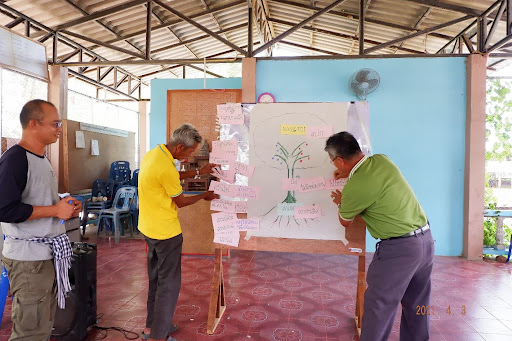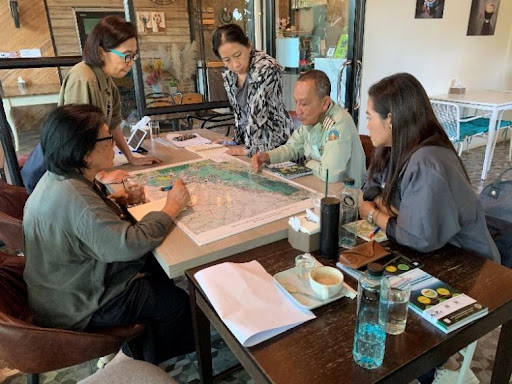6.1
Assessing risks related to impermanence/unsustainability
6.2
Reducing the risk of impermanence/unsustainability of REDD+ and other forest-based climate mitigation programs
Actions to deal with the risk of reversal
Actions under REDD+ and other forest-based climate mitigation mechanisms or programs must support solutions to address drivers of deforestation and forest degradation in the area of operations and adjacent areas. The trends of these drivers need to be monitored regularly and measures should be undertaken to deal with the factors that are likely to contribute to future deforestation and forest degradation in order to reduce the risks of reversal after the project is over or reduce the risks of creating pressure and causing deforestation or degradation in the adjacent areas as the results from REDD+ and other forest-based climate mitigation operations.
Principle
Prevention of the risks for impermanence/unsustainability of the implementations
- Thailand’s commitments in the forest sector to halt deforestation and forest degradation, contribution to climate change mitigation and adaptation, as well as Sustainable Development Goals (SDGs) are defined in key national and sectoral plans including the National Strategy B.E. 2561-2580 (2018-2037), National Master Plan on Sustainable Growth, National Reform Plan on Natural Resource and Environment, the 13th National Economic and Social Development B.E.2566-2570 (2023-2027), and National Forest Policy. By 2037. Thailand set clear goals to achieve 40-55% of forest cover by 2037 which comprised of 25-35% of protected and natural forests, 15% of economic and community forests, and 5% of the urban and suburban green areas. And it is expected to achieve these through conserving biodiversity, ensuring ecosystem services and better quality of life of the people, as well as enhancing governance, equity and participation of all sectors.
- At the operational level, the key agencies have determined specified targets related to forest area and forest land tenure as the following:
1) The 20 years Strategic Plan of the Royal Forest Department B.E.2560-2579 (2017-2036) defines targets under RFD authorization;
# Maintain and increase forest cover in the national forest reserve area up to 53.80 million rai (8.6 million ha)
# Restoration of degraded forest reserve area for 14.02 million rai (2.24 million ha)
# Increase green area and economic forest outside of state forest area for 8.68 million rai (1.39 million ha)
# Forest reserve area designated to be granting use rights to the households living inside the forest reserve for 3.4 million rai (0.54 million ha)
2) The 15 years Action Plan of the Department of National Parks, Wildlife and Plant Conservation B.E.2566-2580 (2023-2037) defines targets under DNP authorization:
# Increase and conserve the protected areas up to 25% of the country’s area or 80.88 million rai (12.94 million ha)
# Restoration of the degraded protected area for 882,200 rai (141,152 ha)
# Number of community granted rights to use the land inside protected area for 4,077 villages, and increase green area in these special areas for 700,000 rai (112,000 ha)
3) The 20 years Action Plan of the Department of Marine and Coastal Resources B.E.2560-2579 (2017-2036):
# Manage and increase mangrove forest area up to 1.68 million rai (0.27 million ha)
# Restore degraded mangrove forest for 100,000-153,400 rai (16,000-24,544 ha)
# Granting use rights to the households living inside the mangrove area not less than 2,800 villages, 70,000 households within an area approximately 80,000 rai (13,223 ha)
- Programs and projects designed to ensure sustaining of activities and address risks of reversal include development of water sources, and sustainable livelihoods for the communities granted used rights in the forest areas to ensure people will have better quality of life while practice eco-friendly lifestyle. The Office of the National Land Policy Board will be an integrated agency to provide technical supports and monitoring to the key departments. And there will be enforcement of forestry and environmental laws and regulations (as mentioned in safeguard E) to create incentives for conservation, equitable sharing of benefits, and prevention of negative impacts to forest and the ecosystem from future development projects/programs.


- Following the current Constitution and National Strategy to transform and increase efficiency of public administration and service using information technology. Relevant ministries and departments have developed monitoring systems on forest, key environmental and socio-economic issues to reflect the results of policies, plans and measures; monitor the trends and risks and therefore taking actions to reduce risks that may arise. The relevant monitoring systems of the country are summarized as the following:
# Monitoring of forest cover and forest resource conditions: - Annual monitoring of national forest cover is implemented by the Royal Forest Department (RFD) (https://www.forest.go.th/land/เอกสารเผยแพร่/), with specific data developed for each forest reserve area and summary by each province. The public can access and view information from an application called National Reserve Forest Information Center (NFIC).
- National Forest Monitoring System (NFMS) is implemented by the Department of National Parks, Wildlife and Plan Conservation (DNP) to undertake survey of forest resource conditions, and monitor the forest cover especially in the protected areas (http://inventory.dnp.go.th/web/downloadpage.html). As well as coordinate with RFD and DMCR to collect data covering all types of forests, data obtained will be a basis to determine the country’s Forest Reference Level (RFL) and Forest Emission Reference Level (FERL).
- Department of Marine and Coastal Resources (DMCR) developed a Provincial Marine and Coastal Resource Administrative System (https://bigdata.dmcr.go.th/) to report updated data on marine and coastal resources including mangrove areas, the public can be access through computer and mobile application.
# Monitoring of destructive events and illegal activities:
- The main three departments developed own systems to provide annual reports of destructive events such as forest fire and illegal activities such as forest encroachment, illegal logging, wildlife hunting, with summary of area affected, estimated economic valuation of damage, etc. (RFD https://change.forest.go.th/, https://forestinfo.forest.go.th/Content.aspx?id=88; DNP https://portal.dnp.go.th/Content?contentId=2134).
- There is a real time fire monitoring system developed by Geo-Informatics and Space Technology Development Agency (Public Organization) – GISTDA (https://fire.gistda.or.th/), which is a national central system providing data for other agencies.
# Monitoring of environmental conditions:
- Monitoring of water situation is developed by the Office of National Water Resources. The real time monitoring of water quantity, quality, as well as provide projection of water related disasters including flood, drought, salinity (https://nationalthaiwater.onwr.go.th/).
- Annual summary on the state of environmental quality, a national report to summarize annual environmental situation supervised by the Office of Natural and Environmental Policy and Planning. The report covers 11 environmental issues 1) Soil resource and land use, 2) Mineral resource, 3) Energy, 4) Forest resource and wildlife, 5) Water resource, 6) Marine and coastal resource, 7) Biodiversity, 8) Pollution situation, 9) Community environment, 10) Natural environment and local art, 11) Climate change and disaster (https://www.onep.go.th/publication-soe/).
# Monitoring of social and economic conditions:
- Data system on social and economic conditions of rural community from the provincial down to the village level, is implemented by the Community Development Department (CDD). The system summarizes key social and economic indicators such as average annual income, average annual expenditure, education level, main occupation, land ownership, happiness level, etc. (http://ebmn.cdd.go.th/#/login)
- Census and survey conducted by the National Statistical Office (NSO) on population, agriculture, economic, key natural resource and environmental issues in order to monitor changes and trends of some important development issues at national and regional levels. (http://www.nso.go.th/sites/2014en/censussurvey, http://www.nso.go.th/sites/2014/สำมะโนสำรวจ).


- Further information on how safeguard F is respected will be compiled and monitored using the following indicators.
6.1.1 Direct and indirect drivers of deforestation and forest degradation, as well as risks of reversals for REDD+ and other forest-based climate mitigation programs are assessed and documented at the national and subnational levels.
6.1.2 Project/program monitoring systems are developed to collect statistical and spatial data and trends to determine drivers of deforestation and forest degradation, as well as risks of reversal.
6.2.2 The National Forest Monitoring System (NFMS) is in place to provide information to monitor and manage reversal risks.
6.2.3 Implementation plans of REDD+ and other forest-based climate mitigation programs identify measures to reduce risks of impermanence and ensure sustainability of the project/program results.
6.1.1 There is a National Forest Monitoring System (NFMS) that provides information to monitor and manage reversal risks.
6.1.2 Direct and indirect drivers of deforestation and forest degradation including the risks of reversal for REDD+ and other forest-based climate mitigation projects; It has been assessed and documented at national and regional levels.
6.1.3 Project/plan monitoring system developed to collect statistical data and trends to identify factors causing deforestation and forest degradation.
6.2.1 REDD+ National Action Plan and other forest-based climate mitigation projects Identify measures to ensure the sustainability of project/project outcomes.
6.2.2 Explanation of existing policies, laws, regulations, and measures of the Ministry of Natural Resources and Environment. and other relevant ministries concerned with improving the quality of life and alternative livelihoods for local communities and ethnic groups. Especially those who live in or around the forest area so that the community can live in harmony with the forest sustainably
6.2.3 Implementation plans of REDD+ and other forest-based climate mitigation programs identify measures to reduce risks of impermanence and ensure sustainability of the project/program results.
6.1.1 There is a National Forest Monitoring System (NFMS) that provides information to monitor and manage reversal risks.
6.1.2 Direct and indirect drivers of deforestation and forest degradation including the risks of reversal for REDD+ and other forest-based climate mitigation projects; It has been assessed and documented at national and regional levels.
6.1.3 Project/plan monitoring system developed to collect statistical data and trends to identify factors causing deforestation and forest degradation.
6.2.1 REDD+ National Action Plan and other forest-based climate mitigation projects Identify measures to ensure the sustainability of project/project outcomes.
6.2.2 Explanation of existing policies, laws, regulations, and measures of the Ministry of Natural Resources and Environment. and other relevant ministries concerned with improving the quality of life and alternative livelihoods for local communities and ethnic groups. Especially those who live in or around the forest area so that the community can live in harmony with the forest sustainably
6.2.3 Implementation plans of REDD+ and other forest-based climate mitigation programs identify measures to reduce risks of impermanence and ensure sustainability of the project/program results.
E1.3.1 The country's existing policies, laws, regulations and procedures prevent and mitigate the impacts of any projects implemented in the forest areas on ecological services, and enhancing the social and environmental benefits of forests (e.g. EIA/EHIA, SEA, etc.).
E1.3.2 Number of project plans/plans that specify measures to prevent and mitigate impacts from ecosystem service operations. and existing social and environmental values
E1.3.3 Area (rai) of natural or planted forests as well as urban and sub-urban green areas (such as agroforestry, community forest, urban forest/park) that contribute to enhancing ecological services and local livelihoods supported and promoted by projects/programs.
E1.3.4 Description of ecological services being restored/maintained/improved (e.g. water and food security Disaster risk reduction Adding a species community life and sustainable product use, etc.) in areas where projects/plans are being implemented
E1.3.5 The economic and social conditions of communities in the operation area have been improved. By comparing before and after implementing the project/project. (Especially the condition of ethnic groups Vulnerable groups such as women, seniors and youth)
